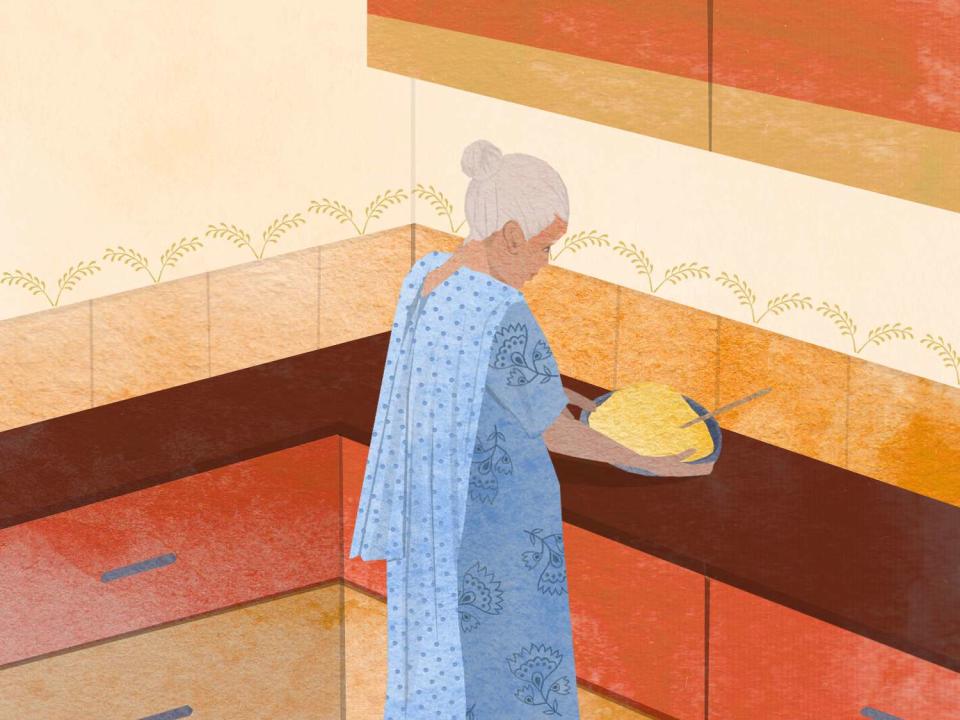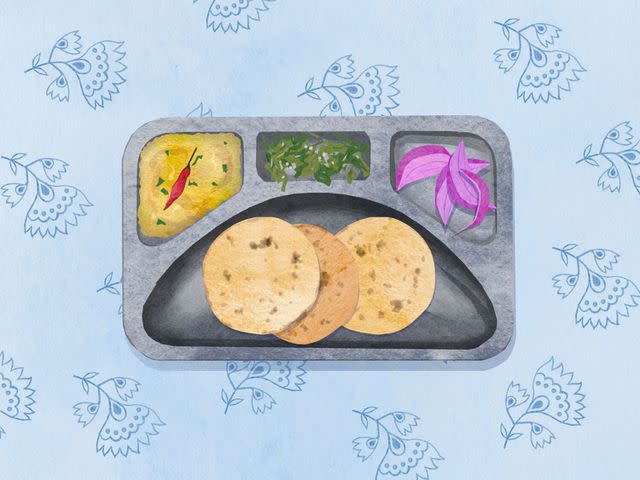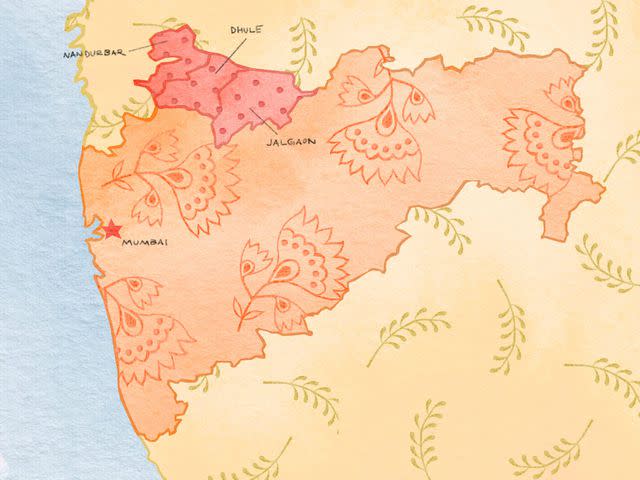Ajji's Cooking: Preserving an Unsung Cuisine
A grandmother's lovingly home-cooked meals constitute a precious, and fragile, connection to the lesser-known cuisines of India's Maharashtra state.

Serious Eats / Tram Nguyen
The pleasures of Ajji’s cooking are simple: the immensely comforting varan phal; the masala-smacked shev bhaji; the soothing kakdichi koshimbir, which you can literally eat by the bowlful, an honor accorded to no other salad. Ajji was my maternal grandmother, and she always, always cooked too much. She made the kind of food that you eat every day and think nothing of, the kind you assume will always be around and so, happily, luxuriously, you take it for granted.
Bajrichya mutkya: noodles made of pearl millet flour, lightly fried in oil tempered with green chiles, mustard, and turmeric. Aamti, or dal, with tadka in it, the shock of mustard, tamarind, and curry leaves sitting a little bit spicy, a little bit tangy, on the tongue. Methichi gola bhaji—toor dal, or pigeon peas, cooked to a slightly thicker consistency than aamti, made with fenugreek and best served with hot-hot chapatis and a side of intensely fiery chile-garlic thecha.
Intensely fiery chile-garlic thecha? It feels so strange, so unnecessarily fanciful to attempt to describe in English something we ate almost all the time. It took me two whole days to figure out how best to describe aamti. Unlike the rhapsodies that a perfectly crispy samosa, a fluffy-flaky Malabari parotta, or a handi full of biryani might inspire, this is just food. Food we ate at lunch and dinner when we visited my grandparents, who lived in the same place they had always lived—Naupada in Thane West, a quiet middle-class Maharashtrian neighborhood in suburban Mumbai, always a little too far from everywhere.
When all of us would visit, Ajji and my grandfather would fly into a flurry of activity. Grandpa, or Ajoba, would set out to bring us the piping-hot batata vadas we loved—plump potato fritters, served with red garlic chutney—always picking them up from this one vendor who sold them through the window of his home. And then, on the way back, the soft, pillowy pav, to nestle the vadas into. “Bring the pav from Meena Stores,” Ajji called out, every single time. “I don’t trust that window place.” She could always tell when Ajoba tried to sneak it past her.
I can still see her in the kitchen now, cooking too much. Two kinds of sabzi (vegetables cooked in a sauce), a salad, one type of dal, rotis, and at least three different kinds of pickles. I’m eight, maybe, and still not trusted around the gas stove, but even Mum isn’t allowed to help with anything but prep.
Ajji presides over the main dishes, shooing everyone away to the dining table, and, once everything is served, watching every plate with a hawk’s eye. For my stoic, no-nonsense grandmother, love is coded in the food she makes. “Wait, have more dal,” she instructs, jumping up to get it. When my cousins or I insist on getting it ourselves, she peers suspiciously. “You didn’t put any ghee on it; wait, sit there, I’m getting the ghee.”
Once we have cleared our stainless steel plates—she always demanded that we be able to see our reflection in them—she is satisfied.
* *
Ajji’s food belonged to the part of the Deshastha Brahmin community that had settled in Khandesh, a hot, parched region on the northwestern edges of Maharashtra state. It was what she grew up eating, what she learned to cook and re-created in the kitchen of her new Mumbai home when she moved there after marriage at age 22.

Serious Eats / Tram Nguyen
“Bhakri, thecha, aani varnacha gola,” she told me—in Marathi, my mother tongue—describing the usual midday meal of the average Khandeshi farmer. Bhakri: a coarse, unleavened flatbread, cooked on a broad skillet or over an open flame. Thecha: a kind of chutney, packed with tempered ground chiles and garlic, the hotter the better—spicy food was said to keep you cool, especially in the region’s drought-stricken summers, when temperatures routinely shot past 100°F (38°C). And varnacha gola: dal meant to be cooked so thick it almost resembled a ball, or gola. Perhaps a raw red onion, quartered, to round off the meal. This sparse assembly, carried to the fields by the farmers at the crack of dawn, or brought from home by their wives at midday, was what you ate, day after day.
* *
Guests who sat at the glass-topped dining table in Ajji and Ajoba’s home were afforded more variety. In the evenings, I’d stand in the kitchen with her, filling up the blue Pearlpet bottles from the water-filtering machine up on the wall. Ajji would be by the stove, adding a heap of finely chopped onion to sizzling oil in a kadhla—the small, heavy iron wok that had been around since before I was born. The onions would soon turn crispy-brown and, once liberally doused in chile powder and salt, were ready to be eaten with soft rice bhakri, on their own or mixed with a bit of curds.
Ajji called this condiment tikhat, which simply means “spicy.” You can make it with garlic, too, or make kharda—a coarse chutney of green chiles that’s a drier version of the thecha. Or maybe a chutney made with oilseeds, like niger (kaarlyachi chatni) or flax (javsaachi chatni).
All of these preparations, made almost instantly with barely two or three ingredients, were beloved condiments for us. But they were also what so many families from the region—working long hours for not enough income—grew up eating with bhakri as a full meal. It would almost always be a jowar bhakri, made with sorghum instead of rice flour. Rice was a luxury.
I watched Ajji cook, and put a pot of tea on. In our household, we have a rather appalling habit of compulsively drinking chaha (“chai” in Marathi) at all hours of the day.
Ajji, I told her, I should write all these recipes down soon. Tell me again then, okay?
“Write down?” she laughed. “What’s there to write down?” Because in her world, there were no fixed recipes, just the way to do it.
But I decided I would, maybe the next time I visited. Then that visit came and went, and I promptly forgot. It’s fine, I thought; there’s plenty of time.
* *
It’s almost a foreign land to me, Khandesh—worlds away from the coastal city of Mumbai in the same state. Once an administrative division in colonial India, the name refers to the collective of the districts of Nandurbar, Dhule, and Jalgaon where Ajji—Pushpa Ayachit, née Deshpande—grew up.
Her childhood was tumultuous; her mother died early from illness, and her father remarried. His new wife didn’t like Ajji, and much of her childhood was marked by a deep loneliness. It was something she never really talked about, except for stray mentions here and there in the stories she told her grandkids over the years. But she spoke about other things: the decades-long friendships she found, the teachers who inspired her to go on to teach herself and eventually become headmistress at an elementary school, the festivals they celebrated, and the food they ate.
The household diet was a mix of two different but not dissimilar cultures. Ajji’s family, living in Khandesh, belonged to the Deshastha Brahmin subcaste. Deshastha literally translates to “residents of the country,” and the country in question is the Deccan Plateau adjacent to the Sahyadri mountains, and the valleys of the Godavari and Krishna rivers.
The community was scattered all over Maharashtra and a couple of the neighboring states, and Ajji’s family was among those who set down roots in Khandesh, an area with an unforgiving climate, seemingly endless summers, and land that allowed for little fresh produce. What did grow in abundance was grain—the millets, cereals, and pulses that form the bulk of both the Khandeshi and the Deshastha diets.
However, my grandmother’s family kitchen took solely from the vegetarian side of Khandeshi food—also known for its fiery chicken and mutton dishes—because, as a Brahmin family, they were strictly vegetarian. India’s oppressive caste system is deeply entrenched in the food cultures of this region, and dietary restrictions are one of the most overt ways of signifying one’s caste and the social status it confers upon a group, independent of any individual wealth. Ajji, as a Deshastha Brahmin woman, would not have cooked or touched meat, which would have been an affront to caste "purity." This dietary restriction, seemingly small and innocuous enough at an individual level, continues today, with damage on a considerably larger scale.
For those who could afford them, the everyday staples tended to remain largely the same. In Ajji’s family, as in many others across the region, Deshastha recipes found parallels in Khandeshi cuisine through plentiful hardy millets, like jowar and bajra; a love for spice; and the use of buttermilk by the gallon. Everything had to be nutritious, cheap, and quickly made; there just wasn’t enough time or energy left over from hard labor to sit stirring a pot for hours.
But simple variations could turn an everyday meal into an indulgence. “My grandfather's absolute favorite aamti, and perhaps mine, too, is the saandge-paapdaachi-aamti,” recalls food writer and consultant Saee Koranne-Khandekar, who walked me through the history of these cuisines, particularly Deshastha, as I tried to fill in the gaps left by Ajji’s declining memory. “It’s a standard aamti served à la minute with fried saandge [crispy nuggets made from a variety of pulses] and papad dunked in it. Over rice with a drizzle of fresh ghee, this was quite a treat!”
The same could be said of the immensely satisfying varan phal (also known as chakolya), which perhaps can best be described as Maharashtrian pasta, with squares of wheat dough swimming in spicy-tangy dal. Or the vangyache bharit, which uses one of the very few vegetables available—roasted eggplant, mashed with curds. Or the masala-flecked saandge that you could happily eat a sackful of. Each of them so simple but so inventive, doing its best to work with an uncooperative climate.
* *
Suddenly, as it always goes, there was no more time. Ajoba died after a long illness, though for a time he seemed to be getting better. The bereaved family did not cook; instead, neighbors and loved ones brought over food. There were 13 days of mourning following the cremation, during which people poured in to offer their condolences, making us retell the same story over and over again.
Yes, very shocking. Yes, we thought he was getting better. Yes, he went peacefully; would you like some tea? Tea, so much tea. Constantly brewing, for the endless stream of visitors, until even we—faithful chaha acolytes—started to grow sick of it.
Ajji barely ate. One weekend, we ordered the pizza she liked, and she had a bite. We got the vada pav—pav from Meena Stores, of course—and she tried some. But for the most part, even weeks after, food, both the eating and the cooking of it, seemed to have fallen out of her favor.
We talked about Ajoba late into the nights, all of us recalling our favorite stories. Every so often, someone forgot a minor detail, and we racked our heads for a bit.
“What was the name of that annoying friend he had? No, not that one; the other one.” “No, no, that didn’t happen during Diwali; wasn’t it the Ganesh festival?”
These once used to be throwaway parts of the story. We used to fill in the gaps where our memory gave up simply by calling out to Ajoba, who would be watching the nighttime news or reading in the armchair by the window. He’d shout out the answer, but then come over grinning, and retell the story with relish. And then, as we’d done a hundred times before, we’d ask him for another, and then another—about his years working with the Indian Railways, oddball relatives, the trips he and Ajji took their kids on, still more oddball relatives.
But now, all we could do was try to remember. We kept thinking of things we’d never asked him about; there were stories he had never told, and now they were gone with him.
Prompted by the terror of another loss, I asked Ajji for her stories as often as I could. So many of them centered on food. Kandyachi peeth-perun bhaji—one of her specialties, made with little more than onions and chickpea flour. Kadhi with red pumpkin. The karlyachya kurkurit kachrya—literally, “crunchy slices of bitter gourd”—that Mum adored. (I know. But it tasted pretty damn good.)
I scrawled some of the recipes in a notebook while we watched her favorite prime-time telly serials, while she watered her plants, while we filled the Pearlpet bottles. Everything was “a pinch” or “a whole lot” or “not too much” of something, and suddenly, as she was describing the cooking process, she’d mention an ingredient that she hadn’t included in the original list. As an inexperienced cook who’s terrified of improvisation, I could barely keep up. But in Ajji’s world, there were no strict recipes. There was just the way to do it.
* *

Serious Eats / Tram Nguyen
Khandeshi, Deshastha, Varhadi, Koli, Konkani—the state of Maharashtra is home to so many culinary traditions. Some are polar opposites, some overlap. Try to trace the roots of one, and, as with cuisines from all over, you trace migratory paths and evolutions in lifestyle, and discover where they intersect with other cultures. Several of their recipes, however, have yet to be documented. There are the cookbooks like Ruchira and Annapurna, of course, loved by generations of Maharashtrians, but they are far from enough.
There’s still a massive need to chronicle food born out of oppression, whether of religion or caste. Dalit food, for instance, is barely documented. And there’s a need to talk about the journeys food makes. My Ajji’s dal battya finds parallels in the dal baati of Rajasthan state, north of Maharashtra. Who introduced it to whom? Coincidence? I don’t know. But I do know I’d like to read more about it.
* *
Ajji’s fast-fading memory proved a formidable foe. She came to live with us, but work took me to Beijing, and I didn’t see her again for another year. When we talked on my visit home, she repeated herself over and over. She was constantly distracted. She had cooked for the last time many months ago, and we hadn’t realized. I closed my recipe notebook and just let her talk, about this and that. It was early January, and we sat by the big window, the golden amaltas blossoms outside still green. Mum joined in, along with a lot of chai.
A few days after I got back to Beijing, she was hospitalized for colitis. There were complications, and, soon after, she passed on.
* *
Later, in the weeks and months that followed, I would try to look for more on Ajji’s food and come away frustrated by the dearth of information available. Later, I would talk to Mum, who would fill in many of the gaps for me, but there would always remain, elusive, that one recipe or ingredient we weren’t quite sure about. Later, I’d seek out food writers and historians, who would reiterate the need to pin down well-worn, generations-old recipes on the page, before the people who made them were gone forever.
And it would be then that I’d fully realize the magnificence and inventiveness of Ajji’s cooking. The kind of food that you eat every day and think nothing of, the kind you assume will always be around and so, happily, luxuriously, take for granted. Though it brings you so much joy, it is seemingly so ordinary, almost invisible because of its constant, reassuring presence in your life. Much like Ajji.
November 2018
Read the original article on Serious Eats.

